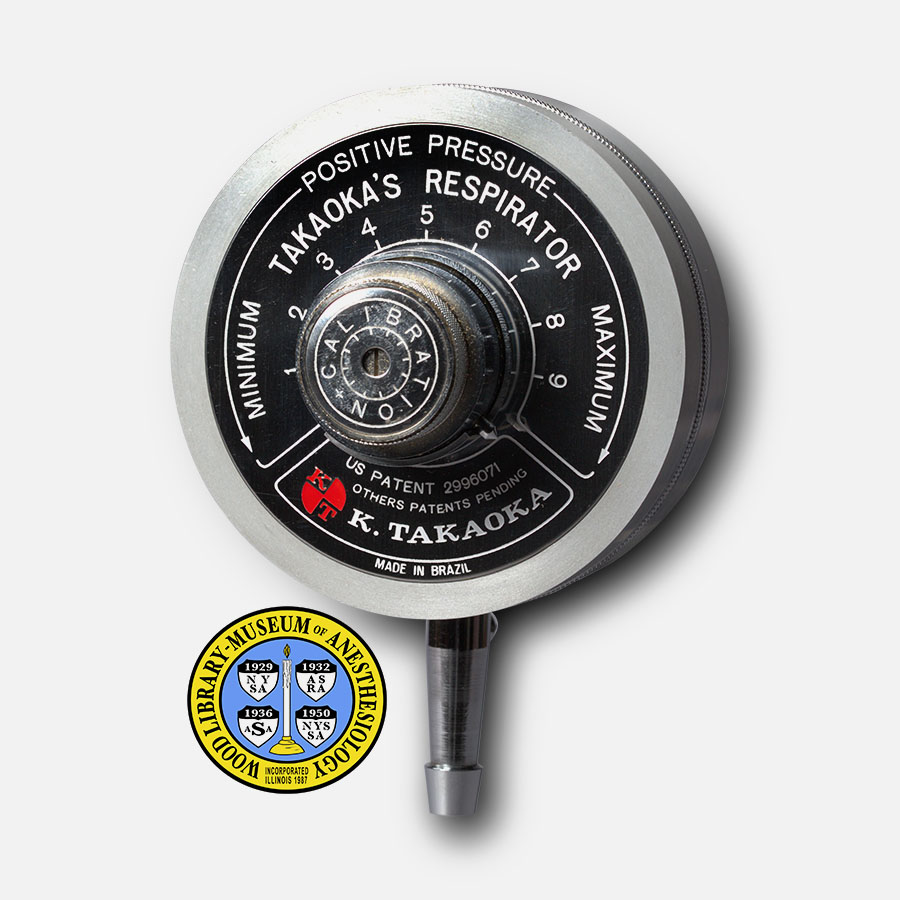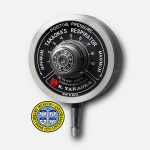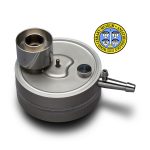Takaoka Respirator
The Takaoka Respirator was designed by Dr. Kentaro Takaoka, who was born in 1919. He had aspired to be an engineer, but dutifully followed in his father’s footsteps instead, and obtained a medical degree in 1944. When his work as an anesthesiologist was hindered by a scarcity of nitrous oxide, he began to design a new type of respirator. Simple, portable and economical, it was intended for use with oxygen and intravenous anesthetics, but it could also be used with inhalation anesthetics. It maintained equal pressures inside both the respirator and the patient’s lungs. The expired gases were vented away from the patient to prevent rebreathing. Later models could be used in a circle breathing system. The respirator was clinically tested in 1955, and two years later, Dr. Takaoka founded a company to produce it. Based in his home town, Saõ Paulo, Brazil, K. Takaoka Industria e Comércio Ltda. grew to manufacture many types of anesthesia equipment.
Catalog Record: Takaoka Respirator Takaoka Respirator
Access Key: amyg
Accession No.: 1995-05-22-1 A
Title: Takaoka’s respirator.
Author: Takaoka, Kentaro, born 1919.
Corporate Author: K.Takaoka Industria e Comercio Ltda.
Title variation: Alt Title
Title: Takaoka Respirator.
Title variation: Alt Title
Title: Takaoka Ventilator.
Publisher: Saõ Paulo, Brazil : K. Takaoka Industria e Comércio Ltda., [between 1957 and 1980?].
Physical Description: 1 respirator : metals, rubber , felt ; 11 x 8 x 9 cm.
Subject: Anesthesia, Inhalation – instrumentation.
Subject: Ventilation, Mechanical.
Subject: Ventilators, Mechanical.
Web Link: https://www.woodlibrarymuseum.org/museum/item/1027/takaoka-respirator
Note Type: General
Notes: This device is described with the regulator knob facing forward, the gas inlet pointing downward, and the connector on the back. The first year in the date range is based on the year that the manufacturer was founded. The last year in the date range is based on the year of publication of the textbook in which a later model of the respirator is described (Mushin et al., 2nd ed.) The materials of construction are described by Mushin et al.
Note Type: General
Notes: Descriptions of the nipple that extends laterally from the gas inlet disagree as to its purpose. Dobkin (1961) states that it is “for sampling the gas (for CO2 analysis) during respiration”. Mushin (1969) states that “the pressure behind the jet is measured on a sphygmomanometer which must be connected to the side-arm of the inlet”. The nipple is not explained in the undated description written by Dr. Takaoka. It is possible that the latter is a translation of Dr. Takaoka’s article published in 1964.
Note Type: Citation
Notes: Aldrete JA. Original contributions of Latin-Americans to anesthesia. Bull Anesth Hist. April, 2002;20(2):1,4-11.
Note Type: Citation
Notes: Biblioteca do Departamento per imagem da Universidade Federal de Saõ Paulo website. http://bibliotecaddiunifesp.blogspot.com/2012/09/revista-conta-historia-do-medico.html. Accessed May 9, 2016.
Note Type: Citation
Notes: Dobkin AB. The Takaoka respirator for automatic ventilation of the lungs. Can Anaesth Soc J. November, 1961;8(6):556-560.
Note Type: Citation
Notes: Meira DG. Kentaro Takaoka, Hospital Das Clinicias De Saõ Paulo e a Anesthesiologica. Braz J Anesthesiol. April-June, 1969;19(2):288-298.
Note Type: Citation
Notes: Mushin WWL, Rendell-Baker L, Thompson PW, Mapleson WW. Automatic Ventilation of the Lungs. 2nd ed. Oxford: Blackwell Scientific Publications, 1969.
Note Type: Citation
Notes: Mushin WWL, Rendell-Baker L, Thompson PW, Mapleson WW. Automatic Ventilation of the Lungs. 3rd ed. Oxford: Blackwell Scientific Publications, 1980.
Note Type: Citation
Notes: Takaoka K. Takaoka respirator. Archives. Located at: Wood Library-Museum of Anesthesiology, Schaumburg, Illinois.
Note Type: Citation
Notes: Venturini AH. A history of anesthesia in South America. In: Eger EI, 2nd., Saidman LJ, Westhorpe RN, eds. The Wondrous Story of Anaesthesia. New York: Springer, 2014.
Note Type: Physical Description
Notes: One respirator; Consists of a squat cylinder, 8 centimeters in diameter, with four extensions; The face is marked “Positive Pressure [new line] Minimum, Takaoka’s Respirator, Maximum [new line, consisting of digits 1 through 9] [new line] U. S. Patent 2996071 [new line] Others Patents Pending [new line] [logo] K. Takaoka [new line] Made in Brazil”;
The first extension is the cylinder-shaped regulator knob, in the center of the “face”; This is approximately 3 centimeters in diameter, and 2.5 centimeters tall; The top of the knob is marked “Calibration +”; The knob rotates fully three-quarters of the diameter of the respirator, so that at the far left of its radius it rests beyond the minimum concentration (1) and at the far right of its radius it rests beyond the maximum concentration (9); A short post extending from the side of this cylinder indicates the selected concentration;
The second extension is the gas inlet, which extends outward (in this orientation, downward) from the side of the respirator (directly below the words “Made in Brazil”); It is 3 centimeters long; On the back of this inlet (facing the anesthesia machine) is a 1 centimeter-long nipple;
On the back of the unit, the third extension is a cylindrical connector that is 2.5 centimeters tall; This consists of two concentric rings; The inner ring surrounds an opening that is approximately 1.5 cm. in diameter; The outer ring is approximately 3 centimeters in diameter; The connector is mounted near the “top” edge of respirator (opposite to the words “Positive Pressure” on the face);
The fourth extension is a the exterior end of the magnetic cycling valve; This is a post that rises through a hole in the back of the respirator, directly below the connector; The post extends .5 centimeter from the opening.
Note Type: Reproduction
Notes: Photographed by Mr. Steve Donisch, January 11, 2016.
Note Type: Acquisition
Notes: Gift of Hubert G. Gootee, M.D.
Note Type: Historical
Notes: Anesthetized patients may need mechanical ventilation to maintain their breathing. Dr. Kentaro Takaoka was born in 1919. He had wanted to be an engineer, but dutifully followed in his father’s footsteps instead, and obtained his medical degree in 1944. When his work as an anesthesiologist was hindered by a scarcity of nitrous oxide, he began to design a new type of respirator. Simple, portable and economical, it was intended for use with oxygen and intravenous anesthetics, but it could also be used with inhalation anesthetics. It maintained equal pressures inside both the respirator and the patient’s lungs. The expired gases were vented away from the patient to prevent rebreathing. Later models could be used in a circle breathing system. The respirator was clinically tested in 1955, and two years later, Dr. Takaoka founded a company to produce it. Based in his home town, Saõ Paulo, Brazil, K. Takaoka Industria e Comércio Ltda. grew to manufacture many types of anesthesia equipment.
Note Type: Publication
Notes: Takaoka K. Respirador automático de Takaoka. Braz J Anesthesiol. October-December, 1964;14(4):380-386.
Note Type: Exhibition
Notes: Selected for the WLM website.



